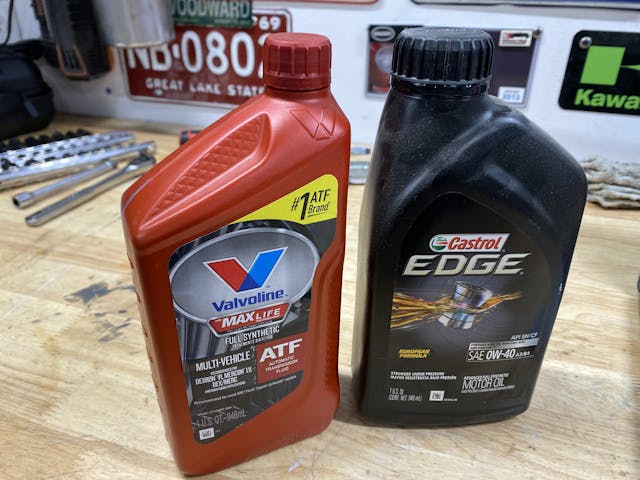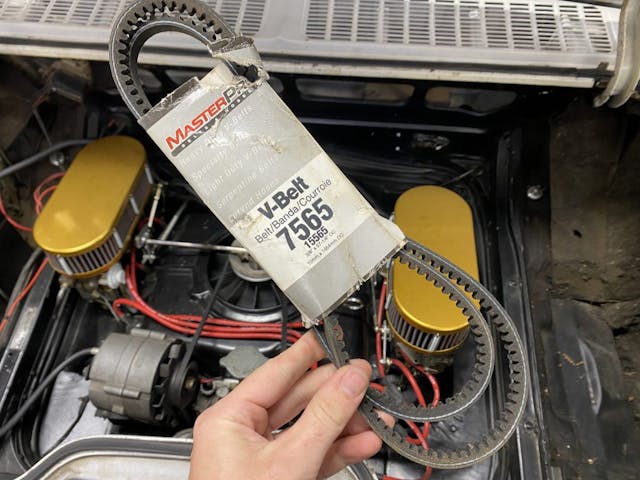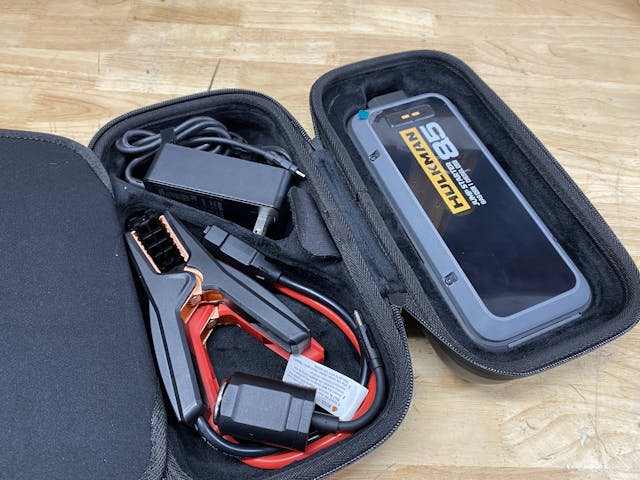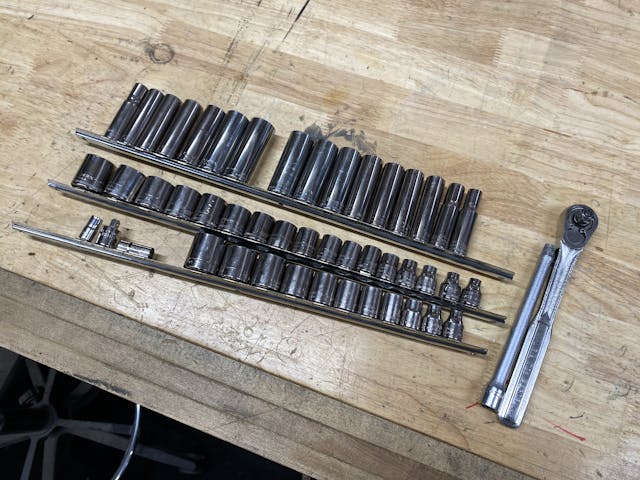Media | Articles
6 essentials for your travel toolkit
Don’t let the fall colors scare you into pickling your car for winter just yet. In many parts of the country, this is the best time to be out on the road. Color tours are spooling up all over the northeast, and as the temps drop in the southwest, vintage cars are returning to the roads—but that means more than a few will likely end up on the roadside too. Set yourself up for success and pack a toolkit to at least handle the basics.
Of course, for bigger trips or questionable cars, it makes sense to pack a big kit that could cover just about everything, but that is not right for every person or situation. As the old saying goes, the best time to build a toolkit for your vintage ride was yesterday and the second best time is right now. Even if you aren’t handy or do your own maintenance it is never known who might stop and offer help and without tools that good Samaritan is reduced to good thoughts. Here are six basic essentials for your travel toolkit.
Screwdrivers
Much of any car is assembled with slotted and Phillips-head screws, and even a precursory inspection often requires removing an access panel or cover. Sometimes a noise or vibration does not indicate immediate death for your car or engine, and after inspection you can determine if it is safe to carry on your way despite some part or piece misbehaving. A screwdriver can also act as a stethoscope in a pinch too, allowing you to track down a goofy noise for better diagnostics with less disassembly.
Pliers
Whether you need to deal with a stubborn spring hose clamp or moving a piece that got a little hot, pliers are the tool for the job. At bare minimum you should carry needle nose and slip joint pliers, as these will cover the vast majority of tasks on the roadside. Bonus points if your needle nose pliers have a cutting edge, as this will work for wiring repairs or stripping.
Fluids
We can’t live without water, and your engine can’t live without oil and coolant. They’re the fluids you’re most likely to lose and can still safely refill and continue your drive. Some folks will tell you to carry brake fluid, but if you’re losing brake fluid, that’s not something to top off and continue. Your brakes are a critical safety system that should be repaired properly by a pro, and your Hagerty roadside assistance card is going to be the best tool to use if the brake reservoir runs out while on the road.
Marketplace
Buy and sell classics with confidence
Belts
Most vintage engines run simple V-belt setups, but that system has been usurped by the serpentine belt. Relying on a chain parts store to have a variety of V-belts can be a big ask since they likely don’t sell many and thus only stock the most popular sizes. Belts are light and pack down small, so having the proper belts for your car is a no brainer.
Jump pack
Batteries go flat. It just happens sometimes, especially on vintage electrical systems in which small draws can go unnoticed until its too late. A jump pack can provide the juice to get your engine running again or keep it running in a real pinch. Also, most jump packs these days are small and light, while also packing more punch than ever. A bonus is it allows you to charge your phone or other critical accessories if you find yourself stranded and waiting for a tow.
Sockets and wrenches
Yeah, duh. It’s hard to take anything apart or service pieces without the ability to remove nuts and bolts. If you are handy and want to carry the bare minimum, start by looking under the hood and picking just the wrenches and sockets for jobs you are willing to do on the roadside. If in doubt, grab a full set of shallow and deep sockets for both SAE and metric, because you never know what hack might be hiding under the hood where someone previously mixed hardware. This also gives you the chance to be the hero in someone else’s story when you have the socket they need in order to leave the car show.
Bonus: Tool roll
Personally, I hate random things rolling around my car, doubly so if they make noise. A simple tool roll is cheap and allows you to keep all your trip-saving bits and pieces together. Tuck it all under a seat or in back with the spare tire, and rest easy each time you take the car out knowing that you’ve got at least the bare minimum needed to keep your trip on the road rather than the shoulder.
Is there something you’d add to a super basic toolkit? Leave your suggestion in the comments below.
Check out the Hagerty Media homepage so you don’t miss a single story, or better yet, bookmark it.




























Thank you for your question. It is always a good idea to have a basic toolkit with you when traveling, just in case you run into any problems. The six essentials you mentioned are a great start, but there are a few other things you might want to consider adding, such as a flashlight, a first aid kit, and a set of jumper cables.
A list like this can be debated ad infinitum, as many drivers will have their own little favorites (I now a guy who thinks a small hammer to tap starters and solenoids and the occasional sticky float bowl is essential), but I will agree that Kyle’s 6 are pretty good. I do find it funny, however, that a guy who drives a Corvair (and even includes a picture of his engine bay) says to “tuck it all…in back with the spare tire”. Where’s your Corvair’s spare now, Mr. Smith? 😁
Duck tape and zip ties
I just hope that Kyle doesn’t have to use that spare belt, because most belts today are die-cut, and Corvairs don’t like these new belts! I have found (thru personal experience) that Clark’s belts work the best. Still, the Dayco is much better than nothing!
As an aside, EVERY Corvair owner really needs to learn how to replace the belt! And not every 9/16 wrench will reach the bolts to loosen the idler pulley. Oh, and you need a 7/16 wrench to loosen the upper belt guide.
My corvair stows the spare in back. 65 corsa.
I thought it was an inspiring article and I agree with the hammer. A few years ago, my wife and I were going to a dog show in NY State, leaving from Nova Scotia. If you’ve been in Boston (Worcester) rush hour traffic, it’s stop & go at highway speeds and the front passenger brake on my wife’s Dodge Caravan jammed on at 6 PM on a Friday evening. As smoke billowed out from the wheel well, we pondered whether to call AAA and got off the highway. If we got the car to a garage, we would miss our show at 9 the next morning. So, I waited until things had cooled down just enough that I didn’t burn myself and used a small hammer my wife had for banging in tent posts. I gently tapped on the caliber and drove it gingerly to the show site. Since then, I pack a hammer and I’ve also got a tire plug kit and a Ryobi tire inflator. Cheers and Happy Motoring!
It’s always good to carry tools with you, but it is extremely unlikely that you are (a) going to be able to fix much of anything on the side of the road, and (b) you are going to have ‘that’ tool. Personally, buy the new belt and stick it on the car. If it is looking shady, change it. If your car throws a (good) belt out on the road, it is probably due to something beyond a roadside fix. same with the fluids – if you are losing enough oil or transmission fluid to make you stop, one quart is probably not going to get you home – and you probably shouldn’t try it. I have one of those parts store tool kits with a ratchet, a selection of 1/4 inch and 3/8 in sockets, bits, and so forth, and I have a multi-screwdriver and vise grips and a pry bar, but the most important tool out on the road is generally a charged cell phone. Call a buddy, drag it back to the house, and fix it properly in the garage
I agree. When my kids began to drive I taught them how to change a tire and I gave them their own tool bag that contained: jumper cables, flashlight, air compressor that plugs into a lighter, and a can of fix a flat. These were to be used only if they were in a mobile dead zone. Otherwise I had Roadside Assist available at their fingertips.
A lot of people off-road or simply travel to locations where there is no cell service. We find ourselves in these situations extremely often.
Cell phone is the best tool as it can fix everything.
Outside changing a hose, belt, tire and or tying up a muffler there is not much on the road you can fix.
I would also say working on the side of the road anymore is not advisable as so many cars are hit anymore by cell drivers and drunk drug attics.
I mostly just keep it simple and keep my phone near by. I would rather pay for a roll back and work at home verses getting hit on the side of the road.
Agreed. Though I carry tools in my old car, I don’t bother with the modern driver. Here is my procedure in a modern car if something goes wrong:
1. I get out of the car and look under the hood.
2. I close the hood and call AAA.
3. I wonder why I performed step one.
Just hope ya got signal!
Great idea !!!!!!!!!!!!!!!!!!!!!!!!!!!!!!!!!!!!!!!!!!!!!!!!!!!!!!!!!!!!!!!!!!!!!!!!!!!!!!!!!!!!!!!!!!!!!!!!!!!!!!!!!!!!!!!!!!!!!!!!!!!!!!!!!!!!
Millennial.
Cell phones seem to be a common “tool” needed. As mentioned, if ur traveling to places where there may be more cows than people, you may not have service.
I find it also alarming that our society still blames most road incidents on drug users and drunk driver. No argument that they aren’t out there but how many people feel that the aforementioned “cell phone” isn’t a bigger issue with “impaired driving”? Ever count how many people in a day you see driving and looking down at their phone while texting?
Hard to blame any of the tools Kyle mentioned in his tool box being the cause of cars and drivers getting hit on the roadside.
Think about that next time you are driving and texting on ur “tool”.
How could you forget duct tape, hose clamps, and bailing wire ? (Vise grips are a must too)
Agree completely—Duct tape will save the world one day !!
Also a rechargable led drop light comes in real handy!
You beat me to it.
Yep
You beat me to it
Bailing wire to tie up a muffler, pipe etc
Can’t use duct tape or tie wraps
as they will melt
Big fan of the tool roll. Basic pliers, Vise grips, screw drivers. I don’t bother with sockets, too much room. I think emergency stuff. Hammer is a must with a chisel (hanging exhaust system, stuck bolts, etc.) Cable ties and electrical tape (both offer mechanical and electrical purposes). Fuses. Tire repair kit (simple plug style) and a can of fix o flat. I carry battery operated red LED flasher “pucks” instead of flares now. Not so much on the fluids, my stuff is down to occasional drips vs gushers….
Here’s something that’s not often thought of until it’s too late. Would your spare — space saver or full tire — utilize the same wheel bolts/lug nuts that your fancy aftermarket wheels do? Compatible socket or wrench, too?
add a gallon of water, pump for tires, patch kit for a tire, flash light and duct tape.
A jack and 4-way lug wrench, mechanics gloves, and proper eye protection-just saying!
Duct tape !!! Preferably Gorilla Tape!!!!
Voltmeter, fuses, some clip leads and gloves.
Agree Bob, you always have to be mindful of Lucas electrics on TR6
Fully-charged cell phone.
A roll of duct tape and thin wire is a must for temporary fixes.
Your AAA membership card?
GOOD IDEA FOR ALL STEPHEN AND MAY I ADD A PLAN WITH 100 MILE TOWING.
For every classic, I carry a small fire extinguisher. You may never need it, but the moment you do, it’s the difference between a small flare up versus total disaster. Actually saved by 69 Chevelle last month from a split fuel hose squirting onto the exhaust manifold causing a small fire. Just a few crispy wires to replace… and a lot of engine compartment detailing. Otherwise, I would have had a Car-B-Que.
a small [digital] MULTIMETER (no needle to get damaged). .. plus SPARE FUSES, and bulbs for lights.
-Duct tape
-Zip ties
-A basic volt/ohm meter
Along with the others mentioned (and some basic ability), can likely get you home or determine if Roadside Asst is the ticket.